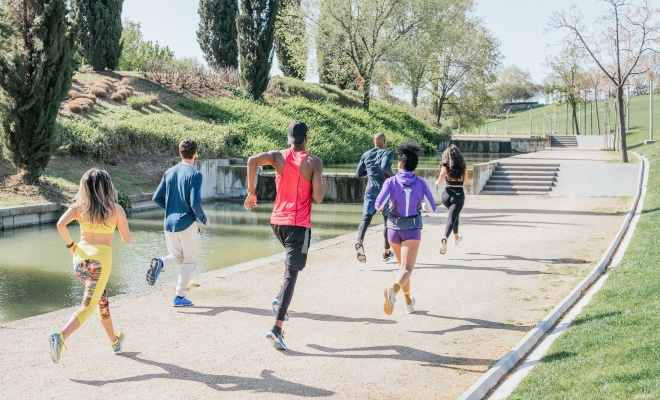"Pain is inevitable, suffering is optional," said Haruki Murakami, a marathon runner and novelist.
For many runners, inner knee pain is a common, yet avoidable battle.
Dive into the nuances of why this happens and how you can run towards a healthier future without it.
What Causes Inner Knee Pain in Runners?
Inner knee pain in runners can often stem from several common issues, including wearing the wrong type of shoes, not stretching enough before and after runs, or simply overusing the muscles and joints without adequate rest. These factors can cause various knee problems, from mild discomfort to severe injuries like runner’s knee or iliotibial band syndrome.
Ignoring these early warning signs of knee pain can lead to more serious complications. For instance, what starts as a minor ache can quickly escalate into a condition that may require extensive treatment or even surgery. Moreover, continuing to run without addressing these initial pains can prolong recovery times and even lead to chronic issues that could sideline you from running altogether.
To manage and prevent inner knee pain effectively, it’s essential to start with some basic self-care measures. Ensure you’re wearing shoes that offer adequate support and fit your foot type and running style. Incorporating a regular stretching routine before and after your runs can also help maintain flexibility and reduce tension in the muscles around the knee. If knee pain persists, it’s crucial to seek a professional diagnosis to understand the specific cause and receive tailored treatment recommendations.
How Can Improper Running Technique Exacerbate Knee Pain?

Running may seem as simple as putting one foot in front of the other, but the way you run can significantly impact your knees. Poor running form, such as overstriding, landing heavily on your heels, or improper foot alignment, puts excessive stress on the knee joints. This improper distribution of force can strain the knee cap and surrounding muscles, leading to pain and inflammation.
The frustration of dealing with recurring knee pain can be demoralizing, especially when it interrupts your training routine or sets back your running goals. Each step taken with poor form can aggravate the knee further, turning what could be an enjoyable run into a painful struggle. This recurring issue not only hampers your performance but can also increase the risk of developing chronic knee conditions.
Addressing poor running technique is crucial for both treatment and prevention of knee pain. A professional assessment of your running form can identify specific errors in your technique, and targeted corrective measures can be implemented to alleviate stress on your knees. This might include adjustments to your stride length, foot landing techniques, or overall posture during running. By improving your running form, you not only reduce the risk of knee pain but also enhance your running efficiency.
Understanding the role of proper equipment in supporting good running form is the next step in ensuring healthy, pain-free running. This leads us to explore how the right gear, especially footwear, can play a significant role in preventing inner knee pain.
What Role Does Equipment Play in Preventing Inner Knee Pain?
Many runners underestimate the impact that the right equipment, particularly running shoes, can have on knee health. There’s a common misconception that any comfortable shoe is suitable for running, or that all running shoes provide the same level of support and protection. However, using inappropriate or worn-out footwear can significantly increase the risk of knee injuries by failing to properly cushion and support the foot and knee during runs.
Imagine running several miles in shoes that lack adequate support—each step sends a shock through your body, directly affecting your knees. Shoes that don’t fit well or that don’t match your running style can lead to improper foot alignment, uneven weight distribution, and ultimately, increased strain on your knees. This can aggravate existing conditions or lead to new injuries, keeping you off the track and potentially leading to long-term knee problems.
To avoid these issues, it’s crucial to choose the right running shoes and other gear that align with your specific needs. Personalized fitting sessions at specialized stores can help determine the best type of footwear based on your foot shape, gait, and the surfaces you run on. Experts recommend replacing running shoes every 300-500 miles to ensure they provide the necessary support. Additionally, consider other gear like knee braces or orthotic inserts, which can also play a significant role in preventing knee pain by providing extra support and alignment corrections.
As you equip yourself with the right running gear, it’s also important to focus on enhancing your body’s own support system. This brings us to the next critical aspect: how stretching and strengthening exercises can not only alleviate but also prevent inner knee pain by bolstering the muscles and structures around the knee.
Can Stretching and Strengthening Exercises Alleviate and Prevent Inner Knee Pain?
A common cause of inner knee pain among runners is a lack of flexibility and muscle imbalances. Tight muscles and weak stabilizing muscles around the knee and hip can lead to misalignment and uneven stress on the knee joint. This imbalance not only increases the risk of injury but can also exacerbate existing pain, leading to a frustrating cycle of setbacks.
The continuous strain from running, coupled with insufficient muscle support, often results in repeated injuries, which can demoralize any runner and stall progress toward running goals. It’s disheartening to feel like you’re always recovering rather than improving, with each step forward met with a painful step back.
To break this cycle, incorporating specific stretching and strengthening exercises into your routine is essential. Stretching exercises like hamstring stretches, quad stretches, and calf stretches can improve flexibility and reduce tension in the muscles supporting the knee. Strengthening exercises such as squats, leg presses, and lateral walks with resistance bands can help build the muscles around the knee, improving stability and shock absorption. Embracing a holistic approach, as advocated by Revival Health and Wellness, means integrating these practices regularly to promote overall joint health and endurance, thereby preventing future injuries.
By reinforcing your body’s natural support mechanisms, you’re not just addressing the symptoms of knee pain but preventing them. This proactive approach leads us to the next important question: Is there a way to run without the fear of knee pain? Let’s explore how adopting the right mental and physical strategies can transform your running experience into a confident and pain-free activity.
Is There a Way to Run Without Fear of Knee Pain?
The fear of knee pain is a significant barrier for many runners, casting a shadow over their love for the sport. This anxiety can be so intense that it not only prevents runners from hitting the pavement but can also infect every stride with worry, making the experience far from enjoyable. The dread of re-injury looms large, especially after one has suffered from knee pain in the past, turning each run into a cautious, stress-filled endeavor.
Imagine you’re a runner who’s constantly holding back, afraid that pushing too hard will lead to another painful setback. This fear can sideline even the most enthusiastic athletes, keeping them from participating in races or achieving new personal bests. It becomes a mental block, as formidable as any physical ailment, that keeps runners from fully engaging with their passion.
To move beyond this fear, adopting certain methods and mindset shifts is essential. My philosophy encourages embracing a holistic approach to overcome these mental and physical barriers. Techniques such as guided imagery, where you visualize yourself running pain-free, and mindfulness practices that focus on body awareness can greatly reduce anxiety. Additionally, setting incremental, realistic running goals can help rebuild confidence and prove that pain-free running is possible.
By changing how you think about and react to knee pain, you can reclaim the joy of running and push past the fears that hold you back. This mindset shift is not always easy to achieve alone, which brings us to consider the next steps. How can you implement these strategies effectively? Is it something you can do on your own, or should you seek professional guidance to ensure you’re not just running, but thriving? This leads us directly into our conclusion where we discuss how engaging with a specialist can transform your approach to running and help you achieve a pain-free lifestyle.
Ready to Leave Knee Pain Behind and Enhance Your Running?

If knee pain has been holding you back, it’s time to take the next step towards a pain-free running experience. At Revival Health and Wellness, we understand the challenges that runners face and are committed to helping you overcome them. Our personalized care plans are tailored to meet your individual needs, providing you with the expert guidance necessary to improve your running form, strengthen your body, and maintain your overall joint health.
We believe that every runner deserves to enjoy their runs without the fear of pain. That’s why our approach combines the latest in sports science with holistic wellness practices, ensuring that you get the comprehensive care you need. Whether you’re dealing with recurring knee pain or looking to prevent future injuries, our team is here to support you every step of the way.
Don’t let knee pain dictate your running journey. Book a discovery session with us today, and let’s work together to craft a running plan that keeps you moving forward, pain-free. Remember, a healthier, more enjoyable running experience is just one appointment away. Let’s start your path to recovery and return to the run without fear or discomfort.






